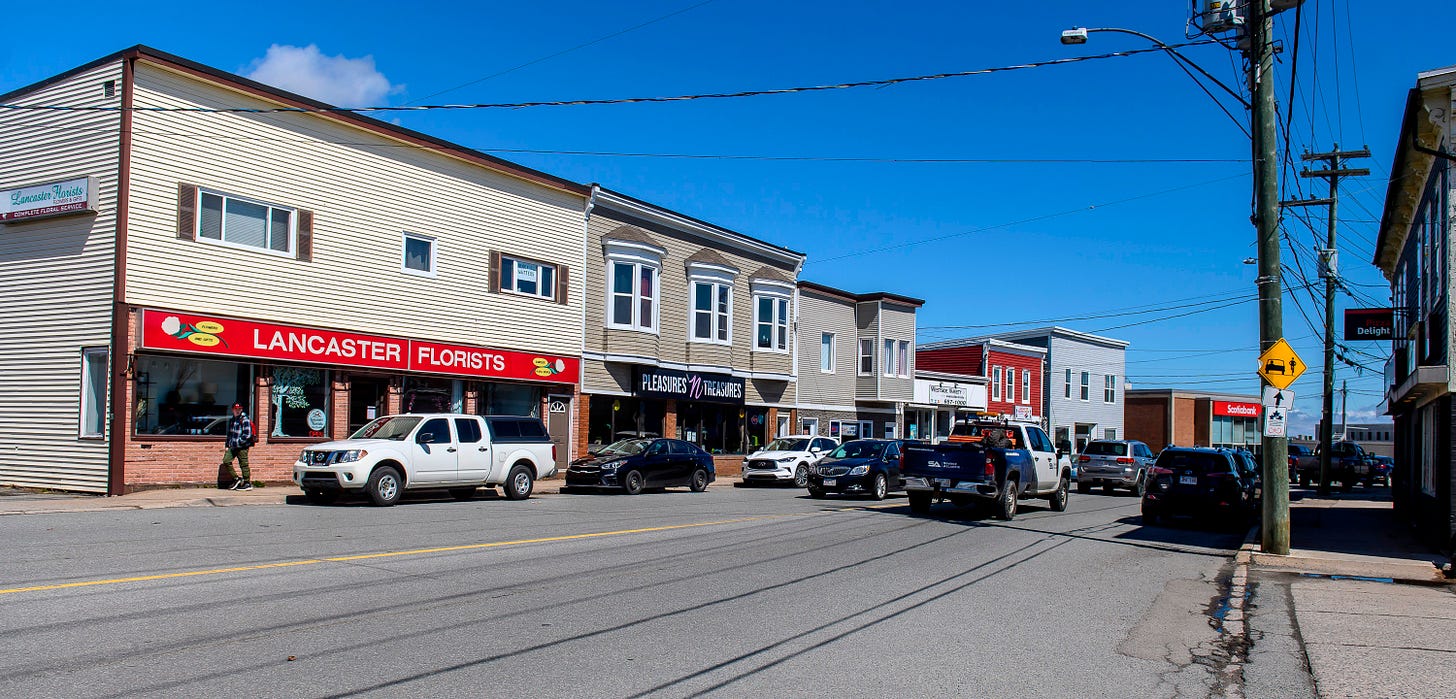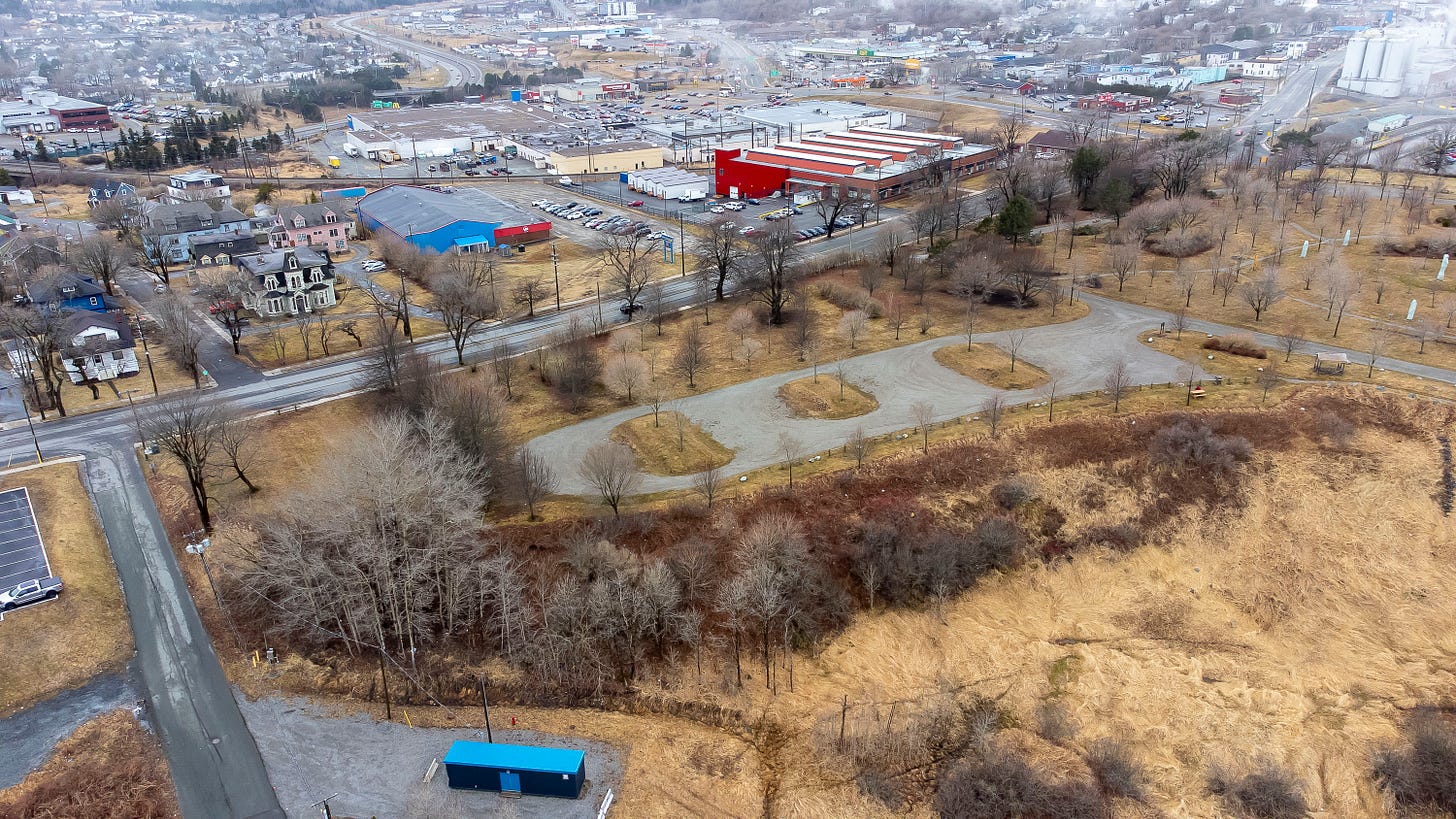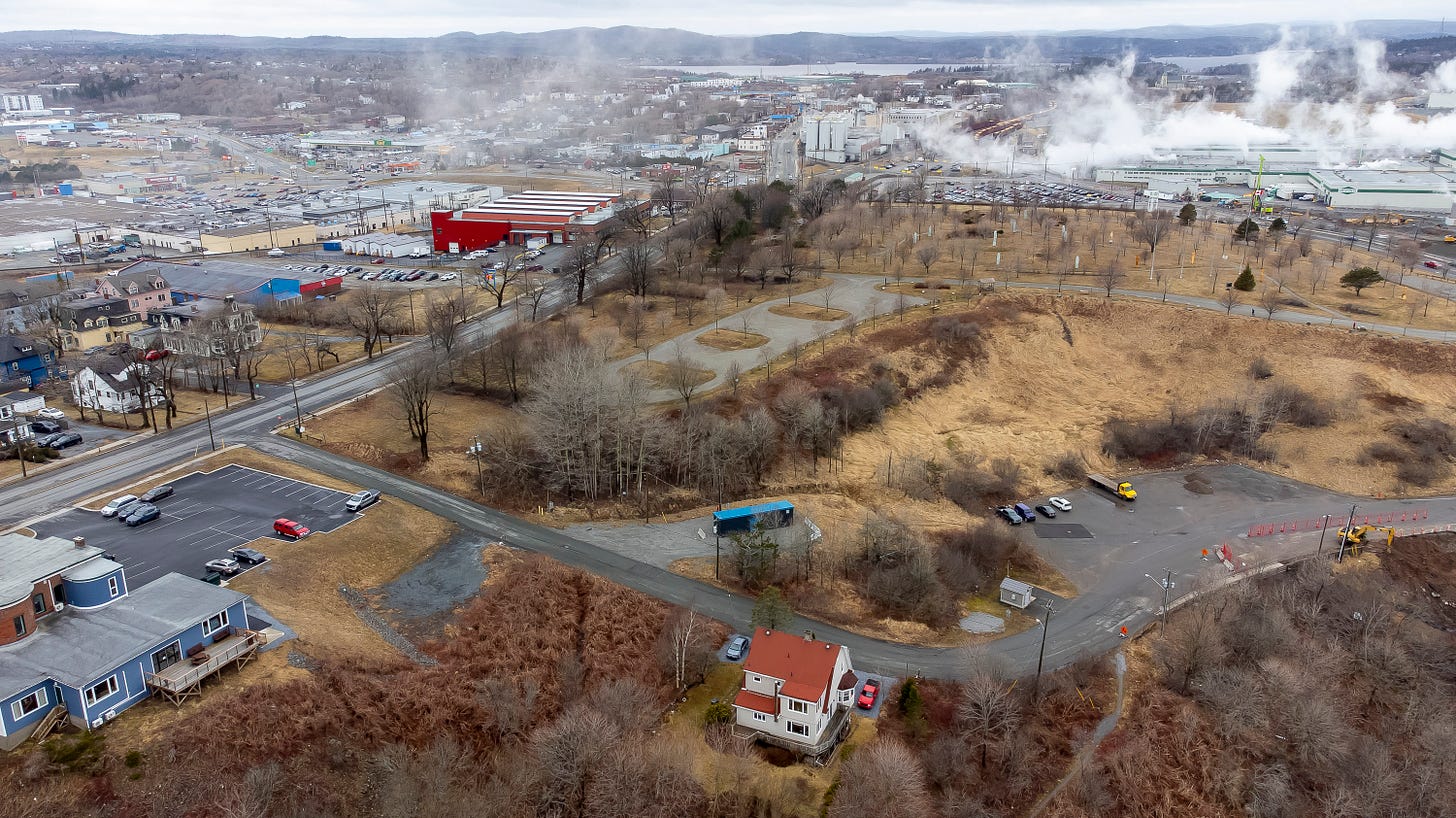Will Saint John Get on Board?
Talk of a possible $70-million overpass for Simms Corner brings Canada's newly assertive trade agenda home to New Brunswick's Port City

Hi Everyone! This is our first story in our first story series. We’re publishing four stories this week about Saint John’s role in Canada’s new national east-west trade agenda, and how Saint John citizens, industry and City Hall reconcile long-simmering doubts about each other to make a singular national vision work in a city often at odds with itself. Hope you enjoy our reporting and news analysis – and please consider subscribing. We have both a free version, which includes one story/week, and a paid version, with the latter giving you access to all our stories.
Saint John may be the first stop on Canada’s newly assertive ‘Elbows Up’ east-west trade corridor, but it’s not cars and trucks driving the ‘one economy’ agenda – it’s ships and trains.
Pre-design work has begun on converting Simm’s Corner, the city’s infamous west side intersection – and one of the options is an overpass running east-west between the Reversing Falls Bridge and Fairville Blvd, leaving Simms Corner clear at street level for trains.
Saint John, with its deep-water port and its well-publicized standing as the Canadian city most vulnerable to U.S. tariffs, is on track to be one of the first places to test drive this new direction, and trains are key.
Why? Because there are only two ways for goods to get in and out of Port Saint John’s West Side terminal: by truck via Highway 1 or by train via Simms Corner, which is both an intersection and a neighbourhood.
In an interview with the Telegraph-Journal in late March, Saint John Mayor Donna Reardon estimated the Simms Corner redesign project, if it includes train traffic, could cost $70 million.1
“We’re committed to a third of that cost – without the trains it would probably cost $10-12 million,” she told the newspaper. “With the trains, I guess then it goes up to $70 million, so we’d be looking for provincial and federal support.”

To prepare, the City of Saint John, Port Saint John, J.D. Irving Limited (JDI), and the Government of New Brunswick’s Regional Development Corporation (RDC) and Department of Transportation and Infrastructure (DTI) have been meeting since last fall.
Earlier this year, DTI awarded the Simms Corner design work contract to global engineering firm EXP, which has offices in Saint John, Fredericton and Moncton, with the planning and pre-design phase now underway.
An overpass is the not-so-quiet talk in Saint John business circles, and it earned a mention at the April 3rd Common Council meeting.
Councillor Gerry Lowe, during his turn at the microphone regarding JDI’s request to rezone its Simms Corner-adjacent Wolostoq Park to create a parking lot for its NextGen project, mused that the parking lot could be used for other projects too.
“Maybe they’ll use it to hopefully build an overpass someday.”2
Side Walks is fully funded by readers and organizations that support our mission to produce local journalism. If you’re enjoying this story, please consider becoming a paid subscriber, $8/month or $80/year. You can also sign up for a free subscription. All subscriptions deliver Side Walks directly to your email inbox, and you can also read along on the Substack app.
Think of Gina and me as your friendly neighbourhood buskers setting fire to complacency while juggling a mix of coverage, commentary and culture – and this is the point in the show where we pass the hat. We appreciate your support!
Now back to the story…
Building it and preparing for what is coming Saint John’s way, will require citizens, industry and City Hall to reconcile long-simmering doubts about each other in order to make a singular national vision work in a city often at odds with itself.

“To Meet the Needs of the Next 50 Years”
To understand what’s happening at Simms Corner, let’s travel four kilometres southeast to Port Saint John’s container terminal.
Shippers use the term TEU (twenty-foot equivalent unit) to quantify cargo capacity. It is the size of a short, 20-foot container box. In 2023, Port Saint John reported 153,454 TEUs, which gives us a measure of ‘throughput’, a term that encompasses the import and export of cargo through a port.
Last November, Port Saint John and its logistics and terminal operations partner DP World, installed two new cranes, the largest in the Port’s 98-year history, giving it the ability to host larger vessels, such as the 300-metre-long Santa Rosa, which can carry up to 7,000 TEUs.

Today the Port has the capacity to handle 325,000 TEUs; that number will rise to 800,000 TEUs by the end of 2025.
That is 2.5 times the Port’s current capacity, and if throughput were to reach 800,000 TEUs’ capacity, it would mark a 421 per cent increase in the Port’s container cargo movement in just two years.
And that is just container cargo: it does not include the non-containerized breakbulk cargo like Canpotex (potash), Irving Oil, Crosby Foods, Repsol (LNG), or the current site of American Iron and Metal. Nor does it consider ‘heavylift’ (cargo generally over 100 tonnes that requires special lifting equipment) or ‘project cargo’ (a special logistical challenge – often multimodal – that transports all cargo components for a specific large-scale project).
That’s the potential for ship traffic in and out of Saint John.
Then there’s the trains.
Port Saint John is the only Atlantic Canadian port connected to three Class I railways: CN (Canadian National), CPKC (Canadian Pacific Kansas City) and CSX, an American freight carrier that travels the Eastern Seaboard from Mexico to Ontario, Quebec and now New Brunswick.
Those three major carriers travel in and out of Port Saint John’s container terminal via the short line railroad that crosses Simms Corner, which is owned and operated by NBM Railways, a division of JDI.
In a March 6th letter to Saint John Mayor Donna Reardon, DTI deputy minister Rob Taylor wrote that the Simms Corner “project needs to meet the needs of the next 50 years of growth in your city and not only respond to the last 50 years of challenges.”3
He added the project will require “a large investment by all levels of government.”
That is why RDC is on the Simms Corner planning team; it is the arm of the provincial government that funds regional development projects.
Its presence at the table indicates that officials are past the spitballing stage and work has begun on the cost, feasibility and timing for a significant public investment.
For comparison, Saint John’s Mile One Interchange cost $83 million and took seven years to complete. It was built to move transport trucks from the city’s East Side industrial parks and the Irving Oil refinery directly onto Highway 1, avoiding the formerly circuitous route through Saint John’s South End neighbourhood.
“We are committed to doing our part financially and working with you and other stakeholders to leverage existing and future federal funding opportunities,” wrote Taylor.
“We understand that federal funding has played a key role in other similar projects across Canada.”
That would be Transport Canada’s National Trade Corridors Fund for infrastructure projects that improve or increase the flow of goods via airports, roads, transportation facilities, ports and railways.4
That fund will likely get a significant boost following the April 28th federal election because both the Conservatives and the Liberals have made increasing trade a central campaign promise.
Those box cars that rumble through the West Side’s infamous intersection are hauling an assertive ‘Elbows Up’ national vision that will accelerate after next Monday’s federal election.
Time for Saint John to determine how quickly it intends to get on board.
If you enjoyed this column, please share the love with others who you think would enjoy the conversation we’re having on Side Walks. We’re a Canadian media start-up building a community of fellow Canucks (and the people who love us) interested in finding common ground around complex issues by focusing on local repercussions and opportunities caused by national and global issues. We’re based in New Brunswick, on Canada’s East Coast. Cheers!
Tomorrow on Side Walks: The Corner at the Centre of Things
Canada's muscular new trade agenda is picking up speed; are the neighbourhoods in and around Simms Corner in West Saint John ready for what's coming down the track?
Previous Stories You Might Enjoy
Hello! Bonjour! New Routes Bring New Rules As We Look to European Markets: How Local SMEs Can Turn Compliance into A Competitive Edge in EU Markets.
Are We Scared Enough to Leap? Twenty years after ringing the alarm about New Brunswick's precarious economic state, I'm curious if President Donald Trump's tariff threats will be enough to drive big change in this small province.
Where in the World Can New Brunswick Go? To find new markets, we can start by following the lead of local sales pros who successfully sell newsprint to the world.
Where in the World is New Brunswick? Gasoline & medium oils bound for Maine and Massachusetts lead the way; lobsters and lumber trail behind in a province dependent on the U.S. for 90 per cent of its export market.
Big Banks Have Left the Building in Rural Canada: Enter a community champion with co-operative ambitions to solve for the social isolation, elder fraud and business collapse that happened after the bank left his town.
We’ve Got to Play our Game Canada: Don't let the big guns down south intimidate you; we've got some moves we can make to shift momentum our way.
Paul Hutchings, "Province Assembles Group to Discuss Simms Corner Fix," Telegraph-Journal, March 25, 2025, https://tj.news/saint-john-south/province-assembles-group-to-discuss-simms-corner-fix
The clip of Councillor Gerry Lowe begins at roughly the 47:58 minute mark. YouTube, “City of Saint John Common Council Meeting - April 3, 2025”, YouTube video, 2025.
City of Saint John, "Common Council Meeting Agenda," eSCRIBE, April 15, 2024, https://pub-saintjohn.escribemeetings.com/filestream.ashx?DocumentId=21367.



